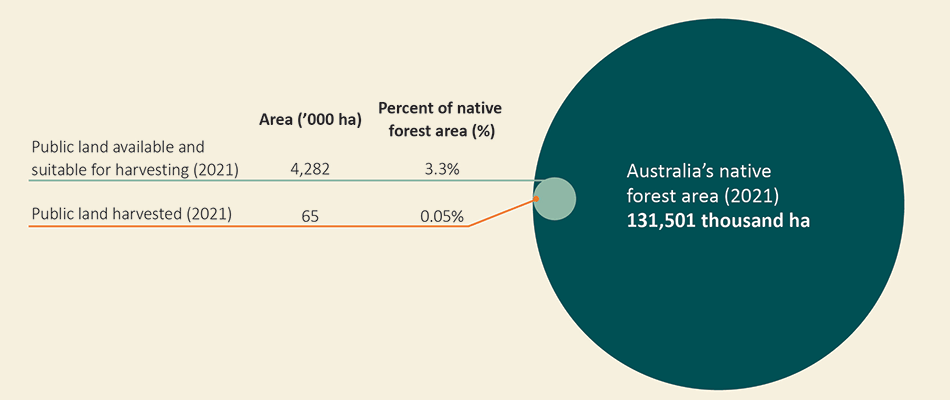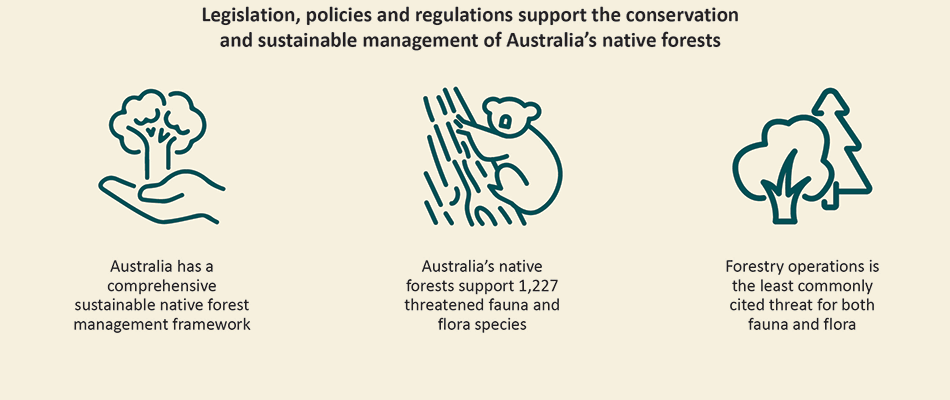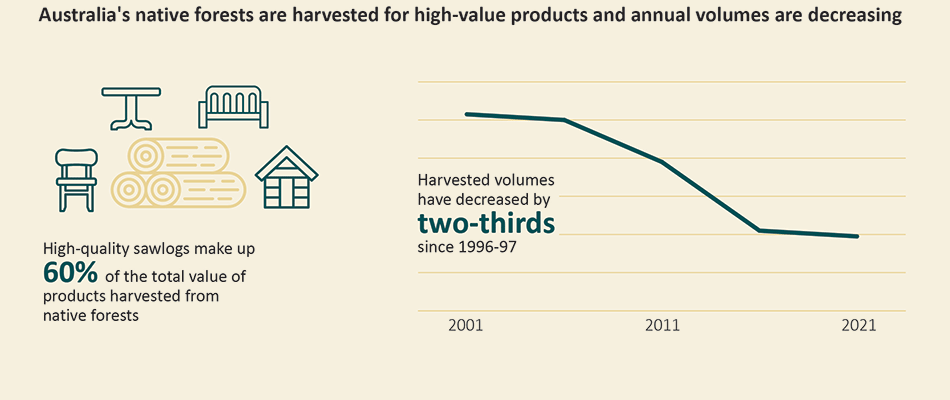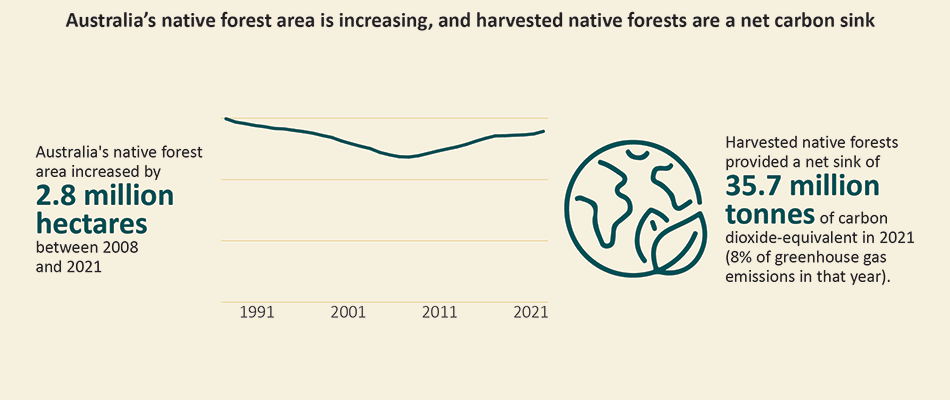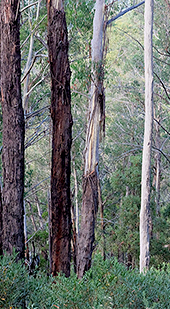
Australia’s native forests and wood production
This Insights paper describes Australia’s native forests managed for wood production, the sustainable wood harvesting that is carried out within them, and other ecosystem services that they provide. Future opportunities and challenges regarding native forests managed for wood production are also discussed.
Overview
Australia’s diverse native forests are valued for a wide range of benefits and services that they provide, including wood products. Around 0.05% of the native forest area is harvested annually from our publicly owned multiple-use forests to sustainably produce important wood products used by Australians such as house frames, decking, flooring, furniture, power poles, pallets, packaging and paper. Australia’s native forests, including forests managed for wood production, support diverse and unique biodiversity and have an important part to play in the fight against climate change. Native forest wood products industries face some significant challenges including diminishing supply and climate change.
Key points
A total 27.4 million hectares (21%) of Australia’s 131.5 million hectares of native forest were available and suitable for commercial wood production on leasehold, private and multiple-use public forest tenures in 2021. However, most of this area (82%) has low commercial potential for wood production due to low volumes of saleable wood and large distances from existing markets.
The area of multiple-use public native forests in which wood harvesting was permitted to occur in 2021 was 4.3 million hectares. This represents less than half (43%) of the total area of multiple-use public native forest, and 3.3% of total native forest.
In 2020-21, a total of 65 thousand hectares of multiple-use public native forest was harvested. This represents 0.7% of the total area of multiple-use public native forest and 0.05% of total native forest area.
Most of the area of multiple-use public native forest harvested in 2020-21 (86%) was ‘selectively’ harvested, which means either individual trees or small groups of trees in an area are selected for harvesting based on their size and condition. The remaining trees that are not harvested in the area provide biodiversity habitat and food resources, and seed for the next generation of trees (growing stock).
Australia has a comprehensive framework of policies and legislation for delivering ecologically sustainable native forest management. Environmental safeguards and forest regeneration requirements are determined and regulated by state and territory governments, and are underpinned by robust scientific data.
Australia’s native forests provide important habitat for unique fauna and flora. As at 2021, they were home to 1,788 vertebrate fauna species and 13,788 vascular flora species. There are, however, threats to our forest-dwelling fauna and flora. This includes 1,227 species (244 vertebrae fauna and 983 vascular flora) listed as threatened (critically endangered, endangered and vulnerable) under the Environment Protection and Biodiversity Conservation Act 1999.
Commonly cited threats in conservation planning documentation for listed threatened forest-dwelling fauna and flora are land-use change and/or forest loss (deforestation), unsuitable fire regimes, and predation/grazing by introduced fauna. Forestry operations is the least commonly cited threat for both fauna and flora.
Wood products from sustainably managed native forests are renewable because trees regrow again after a harvesting operation on a continuing cycle. Wood products are climate friendly because they are relatively energy efficient to produce, they store carbon, are recyclable, and break down into organic material.
Timber from Australia’s native forests is sought after because it is visually attractive, dense, strong and durable. Most hardwood sawlogs produced in Australia are sourced from native forests (72% in 2020-21), with a smaller amount produced in hardwood plantations.
Native forest harvesting operations generally target high-value products such as sawlogs, veneer and poles. Pulplogs, firewood and other lower quality products are typically produced as a byproduct of sawlog harvesting.
The average annual volume of sawlogs, pulplogs and other hardwood products harvested from native forests during the period 2016-17 to 2020-21 was 3.9 million cubic metres. This is about a third of the 10.3 million cubic metres that were harvested annually during the 1996-97 to 2000-01 period.
Native forest makes up 98% of Australia’s total forest area, or 131.5 million hectares. Queensland has the largest area of native forest (39% of total native forest area), with other large areas in the Northern Territory (18%), Western Australia (16%), and New South Wales (15%).
Between 2008 and 2021, the total forest area increased by 2.8 million hectares. Most of this increase was due to native forest regrowing on land previously cleared for agriculture.
Sustainable wood harvesting in native forests can help combat climate change. As trees grow, they remove carbon dioxide from the air and release oxygen. Harvested wood products can store carbon for potentially many decades. Substituting carbon-intensive products such as concrete and steel with sustainably produced wood products, and utilising harvesting residues for bioenergy, can further reduce greenhouse gas (GHG) emissions.
The total amount of carbon stored in Australia’s native forests in 2021 was 19,205 million tonnes. This was an increase of 27 million tonnes since 2016. Harvested native forests provided a net sink of 35.7 million tonnes of carbon dioxide in 2021, corresponding to 8% of Australia’s total GHG emissions in that year.

